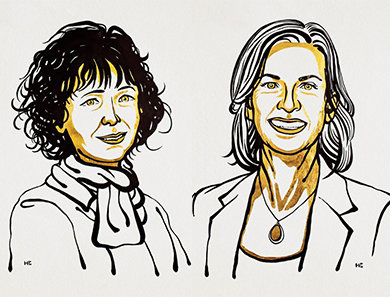Invented
The genetic scissors
Scientists use technologies that can manipulate the genetic information in cells to ascertain the function of these genes, among other things. That is time consuming, difficult and an often impossible job. Now, in 2020, it is possible to change the genome - the code of life - within a few weeks. This is possible using the so-called CRISPR/Cas9 method: the “genetic scissors”. Scientists Emmanuelle Charpentier and Jennifer A. Doudna received the Nobel Prize in Chemistry in October 2020 for their contributions to the development of this method.
Effective treatment of diseases
This method offers an enormous range of options to intervene with the genetic code of living organisms, both of people and animals as well as micro-organisms and plants. This can be beneficial when treating diseases, such as cancer and genetic diseases. The CRISPR/Cas9 technology can also be applied to agricultural crops. By editing the genome, you can give the crop the desired characteristics, whereby it becomes resistant to pathogens or grows faster and eventually provides a higher yield.
How the genetic scissors work
CRISPR, which stands for Clustered Regularly Interspaced Short Palindromic Repeats, is a piece of DNA, a so-called DNA sequence. CRISPR sequences were first discovered in bacteria and archaea, in which they are part of an adaptive immune system that can recognize infectious viruses. Once CRISPR recognizes the virus, a mechanism comes into operation whereby enzymes (such as Cas9) can “cut” the genetic material of the viruses and make them harmless. In this way, disease-causing or other undesirable genes are turned off, or “healthy” and desirable genes can even be inserted into the genome.
This system has been modified by scientists in such a way that it also works in animal and plant cells. CRISPR sequences are developed so that they specifically recognize the relevant part of the genome of these cells. The CRISPR sequence leads the Cas9 enzyme, for example, to that part of the genome which is selectively cut.
New generation of inventions
In 2012, Doudna and Charpentier applied for a patent for the CRISPR/Cas9 technology, as did various other research groups that had been working with CRISPR/Cas9. Indeed, this new technology opened the floodgates for a whole new generation of inventions. Since 2012, numerous scientists, institutions, and companies have filed almost 10,000 patent applications in this field. A battle has broken out about patent rights to the technology among some of those parties, namely the University of California (to which Doudna is affiliated) and a collaboration between MIT and Harvard University in Boston (Broad Institute, with inventor Zhang). This battle has not yet been settled and may lead to a different outcome at the American Patent Office than at the European Patent Office. Substantive factors play a role in this, such as who was the first to apply the technology in eukaryotic cells, such as animal or plants cells. Additionally, several legal issues play a role, such as whether the patent applications were filed under the name of the right legal person.

Emmanuelle Charpentier (l.) and Jennifer Doudna
@Nobel Media. Ill. Niklas Elmehed
Share